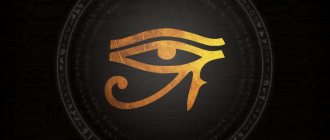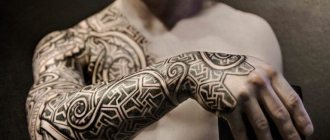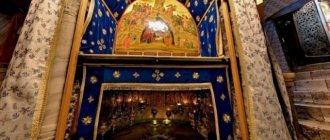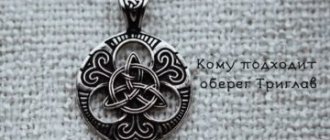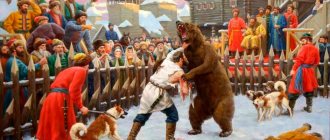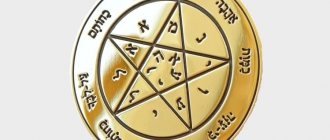The Slavic amulet Star of Rus' or the Square of Svarog belongs to a number of powerful amulets that allow you to receive the protection of not only Svarog, but also other gods and even your ancestors. It contains much more power than some others dedicated to a specific deity or purpose.
The Svarog Square is a very complex symbol that carries within itself the traditions of the ancient Slavs, helping to pass on this knowledge to subsequent generations. This article will help you figure out who the amulet with the Star of Rus' is suitable for, how to activate it, wear it and clean it.
History of origin
Svarogov Square has its own history of origin. According to it, our ancestors decided to create a special sign that would contain the wisdom of previous generations, their knowledge, experience and willpower. The Square of Svarog, also called the Star of Rus' or the Seal of Svarog, became such a symbol.
This sign, dedicated to the blacksmith God Svarog, was used as a personal talisman to help one find one’s path in life, develop in one’s chosen work field, and protect one’s family. It was usually worn in the form of wooden jewelry or rings and even embroidered on clothing.
There is information that the symbol was depicted on the robes of princes Vladimir and Svyatoslav.
⬛ translation into other languages
| Other names | ⬛ Censor⬛ Color Black⬛ Black Large Square⬛ Geometric⬛ Square |
| Title in Spanish: | Cuadrado Negro Grande |
| Spanish keywords: | Cuadrado, Negro, Cuadrado Negro Grande, Geometria |
| Title in Italian: | Quadrato Nero Grande |
| Italian keywords: | Quadrato, Quadrato Nero Grande, Geometria |
| Title in German: | Großes Schwarzes Quadrat |
| German keywords: | Schwarz, Quadrat, Großes Schwarzes Quadrat |
| Title in French: | Grand Carré Noir |
| French keywords: | Forme Géométrique, Grand Carré Noir, Carré |
| Title in Portuguese: | Quadrado Preto Grande |
| Portuguese keywords: | Quadrado, Geometrico, Quadrado Preto Grande |
Symbolism of the amulet
Like any ancient sign, the Svarog Square has its own interpretation. Over the past centuries, a huge number of symbols have come to us without undergoing transformation - retaining their appearance and meaning. But Svarog Square is not one of them. This is one of those signs whose symbolism is still debated among Slavic scholars.
The Star of Rus' is visually very similar to the Star of Lada. Their meaning in some way also has something in common, although it is not identical. Both symbols are an eight-pointed star consisting of a square and intersecting ellipses. But, unlike the Lada symbol, the Star of Svarog has pointed ends of the ellipses, rather than rounded ones.
The Square of Svarog (Star of Rus') has pointed ends of the ellipses, and the Star of Lada has rounded ends.
As for the general symbolism, the opinions of experts agree. It is generally accepted that these two eight-pointed stars contain the harmony of the universe, expressed in three worlds:
- Reveal;
- Rule;
- Navi;
Two intersecting ellipses also mean harmony, but not a general one, related to the Universe, but between representatives of the Slavic family - a man and a woman. With a deeper decoding of the meaning hidden in the signs, everything is much more complicated.
In articles about these signs, their meanings are so mixed up that it may seem as if they are exactly the same. But here it is worth remembering that the Lada Star is a female sign. He helps to fulfill his destiny before Rod as a wife and mother.
The Star of Rus' symbol, on the contrary, is masculine, so it will have a different meaning. In the case of the Seal of Svarog, the square will mean not the family hearth, but the forge in which Svarog himself worked, and the four corners of the ellipse protruding beyond the edges of the square are human virtues.
Name:
- honesty;
- justice;
- Liberty;
- faith.
Square as a symbol
“The square you dreamed of is a symbol of unexpected difficulties” (Dream Interpretation)
Square
is a geometric figure that has a number of mythological, symbolic and other non-traditional interpretations. The square is most clearly associated with the number four, symbolizing concepts such as order, equality, truth, justice, wisdom, honor, sincerity, and earth. The square personifies the four cardinal directions, four seasons, four human ages, and the four basic elements of the world (fire, water, earth, air).
The geometric symbol is associated with the number four, equality, straightness, order, uniformity, earth. Even numbers and shapes are characterized by properties of stability, as opposed to the dynamics of odd numbers and their corresponding geometric shapes. In the system of ethical ideas, truth, justice and wisdom are associated with the square. Psychologically, it is associated with strength and stability, and also means honesty, straightforwardness, sincerity, and morality. This is an image of a stable structure, of static integrity.
The square acts as the main model for structuring the world, in the elementary (four elements), in the spatial (four cardinal directions, top - bottom, left - right), in the temporal (four seasons, stages of human life and eras of mankind) and in the social (four main class) aspect of it. All these quaternary structures set the basis for the order and stability of the universe. For this reason, square-shaped objects associated with the sphere of the sacred can be considered as symbols of the universe (chessboard, shamans’ tambourines).
The symbol expresses a person's orientation in space and direction relative to the vital sphere of light and their supernatural guardians in the sense of "fourfold location". In the square, the desire to navigate a seemingly chaotic world through the introduction of directions and coordinates comes first.
The square denotes the boundaries formed by the four elements designed to support life in all its manifestations. This is a symbol of the land given over to man. In many cultures, a square symbolizes fertility (there is also a square with a dot in the middle, “sown field”, in Russia
This sign was a mandatory element of decorating women's clothing). A square with a cross inscribed in it symbolizes the protection of one’s land.
In Buddhism
the square or cube at the base of the chorten represents the earthly plane of existence.
The Chinese have
a square - the motionless Earth in conjunction with the rotating circle of Heaven. The combined image of a square and a circle (as on old Chinese coins) is a symbol of the union of yin and yang, Earth and Heaven and can also mean a perfectly balanced person. Acting on a square means the Confucian maximum: do not do what you would not want for yourself. A square with a semicircle means order, correctness, laws of virtue, paths of wisdom, a true guide.
The Indians
The square is the main symbol, which is the archetype of order in the universe, the standard of proportion and the ideal for assessing a person. He is the foundation of a temple or any other sacred center and represents the balanced perfection of form, Purusha, essence, space, as well as pairs of opposites, cardinal directions, four castes, etc. Both the circle and the square are symbols of dharma, the order of things in space and in the human world. The square at the base of the stupa represents the symbolic shape of the Earth.
In Iranian mythology
the monastery of the righteous Vara has the shape of a square; this image reflects the idea of a square fence, inside of which there is an ordered world, contrasted with the outside, full of chaos and death.
In the Greco-Roman tradition
the square is a symbol of Aphrodite (Venus) as a female fertile force.
For sealants, a square on the base means stability; a square standing on a corner and with a circle in the middle is anima mundi
. For the Pythagoreans, the square symbolizes the soul.
Magic square
, is believed to concentrate the energy associated with the underlying number.
The most famous are the squares of Sator, Mercury, Saturn, etc. The Sator Square
was primarily used as a love spell. Performed in the form of a talisman, written for a person who wants to be an object of desire. It was also placed on walls and ships in ancient Rome and was considered an amulet against magic, poisoned air, colic and infectious diseases, as well as to protect cow's milk from witches.
The quadruple orientation of the world picture is also expressed in games, for example in the ancient Mexican game patolli
or in
chess
.
But it appears even more clearly in the game of " mill
", the field of which consists of three concentric drawn squares with connecting bars (sometimes at corner points, but usually only in the center of individual sides) and is found in the form of carved rock paintings in the Alpine region (Austria, Italy), in France, England (Isle of Man), in the Balkans, in Afghanistan (Pamir region), as well as on prehistoric ceramics (Villanova and Esta culture, Italy) and on Boeotian idol figures. In the form of rock paintings, it is found not only on horizontal surfaces, but also on steep walls, and therefore it is not always possible to “play” it. Therefore, the symbolic value, exceeding the value of the game board, is irrefutable and is recognized only in connection with old cosmogram paintings.
The square symbolizes the perfect type of enclosed space
and is a model for many religious buildings (pyramids, churches, ziggurats, pagodas, etc.), which, in turn, are considered as a symbolic image of the world.
In sacred architecture it symbolizes transcendental knowledge. The square represents the Earth as opposed to the circle of Heaven, earthly existence, static flawlessness and perfection, immutability, integration, the four elements in their static aspect, the divine manifestation in creation. In the architecture of a sacred building, temple, church, the transformation of a circle into a square or a square into a circle represents the transformation of the spherical shape of Heaven into the square (rectangular) shape of the Earth and vice versa. Thus, the symbolism of the square personifies the processes taking place on Earth, while the symbolism of the circle is an allegory of the higher, supermundane world, the world of the Gods. Reflects the unity of the divine
: three sides of the square are the divine trinity, and the fourth side is the divine unity.
The cross under the square stone is a symbol of the heaviness of the earth, the idea that there is nothing else in the world except the whimsical play of the elements, that the world is hell, a hopeless abyss, a dungeon, Tartarus. On the contrary, the cross above the square stone is a symbol of hope, this is the tree of life that has emerged from the grave, this is the possibility of redemption, resurrection. This sign was often used to designate the “philosopher’s stone,” which supposedly could bestow immortality and eternal youth.
The legendary " squaring the circle"
"(namely, the transformation of a circle with the help of geometric tools into a square of equal area) symbolizes the desire to bring both elements, “heavenly” and “earthly,” into one ideal harmony (lat.
concidentia oppositorum
).
Square
– masculine, circle – feminine.
The rectangle
also symbolizes Purgatory or the Underworld.
The rhombus
represents the feminine creative principle, the vital symbol of fertility goddesses.
Source
The meaning of the Svarozh square
The Svarog Square provides connection with ancestors and the protection of the gods. The one who wears this sign shows that he respects his Family, honors the traditions of past generations and with all his heart wants to support them in order to pass them on to his heirs.
The Svarog Square provides connection with ancestors and the protection of the gods.
The main meaning of the Star of Rus' amulet comes down precisely to fulfilling the duty of a Slav - maintaining the clan in a state of prosperity. For women, this is expressed in creating a family and maintaining a home, and for men, in protecting loved ones and manual labor.
The Svarog Square, the meaning of which we discussed above, does not simply create a connection between a person and his ancestors or a person and the gods. It allows you to find your path in life. If you can't find your calling, the Star of Rus' will send you on the right path. The amulet will also contribute to the accumulation of spiritual strength, bestow wisdom and help in development.
How and from what to make a talisman
After choosing a talisman, a logical question arises: buy or make it yourself.
The easiest option is to order or buy a ready-made amulet from a master. It is not recommended to make a talisman yourself.
A blood relative is best suited for this.
When making a talisman, you need to follow a number of rules:
- Start work during the waxing moon.
- Thoughts should be pure and positive. While doing this, think about the person for whom you are making the amulet.
- There should be no one in the room, only you.
- Light a candle to clear away negative energy.
- Be careful when applying the pattern - everything should be clear, without any inaccuracies in the design.
- There should be no extraneous sounds in the room.
- To work you will need any natural material (leather, wood, clay).
- If you embroider, try not to use scissors and hoops; start stitching from the middle of the fabric, and there should be no tangled threads on the back side.
- Try to make the amulet in one day. In this case, his magical power will increase.
- If the work is not finished, it is removed so that other people cannot see.
- Friday and the first half of Sunday are not suitable for making the Star of Rus' amulet.
IMPORTANT! It is better not to use silver and gold. Copper is well suited for making a ring, for example.
If you know how to work with wood, you can make an amulet yourself.
You may be interested in: The meaning of the symbol (amulet) Kolovrat
To do this, a small cut of wood is taken, sanded, then a mark is applied, and everything is varnished. A talisman made in this way is worn as a pendant.
The Star of Rus' can be drawn on thick cardboard, framed as a picture and hung on the wall in the place where all family members spend the most time.
You can even take a photo of this symbol. However, his power will not disappear.
Other names for the amulet
Some ancient Slavic amulets have several names. Because of this, and also because of some external similarity, many signs are often confused and misused. So the Star of Rus' has several more names. In some sources it is called the Star of Svarog. It’s not hard to guess where this name came from, because the symbol is associated with the Blacksmith of the World.
Another variation of the name for this protective sign is Svarog Square. One of the components of the symbol is this geometric figure - this is what led to the appearance of another name. However, the word “square” itself is not of Slavic origin, but came into the language from Latin relatively recently (around the 18th century). Therefore, the name of the amulet is also probably new.
The Star of Rus' symbol is also popularly called the Square of Svarog, or the Seal of Svarog. Some researchers call this sign the Star of Svarog.
This was the reason that some Slavic scholars call the symbol a “remake,” questioning its use by our ancestors. This is only partly true. The ancient Slavs most likely did not call the amulet “Svarog Square”. The name appeared much later and can be considered a “remake”. But this does not mean that the sign itself is also a fiction; rather, its popularity today has brought new names to the ancient symbol.
Much less often you can find a mention of a talisman under the name Seal of Svarog.
There are claims that the Star of Svarog and the Star of Lada are the same symbol. Experts say completely opposite things, and newcomers to the study of Slavic culture are completely confused. But among all this chaos, there is a very logical version that these are separate signs, and not one whole. They belong to different deities and personify interconnected, but opposite, things - masculine and feminine.
Who is it suitable for?
Don't forget that not all ancient symbols are universal. Some of the amulets with these signs can be worn by both sexes, others are suitable only for women or men, and sometimes only for a certain age category.
The Svarog Square also has its own features of use:
- Only men should wear the Star of Svarog;
- sign not suitable for children;
Compliance with these rules will ensure that the Svarog amulet will fulfill its calling without causing any harm to the owner. So that you do not have doubts and desire to use it differently, we will explain what such restrictions are associated with.
The Svarog Square amulet is exclusively for men; women and children cannot wear it.
The Star amulet carries masculine energy belonging to the blacksmith god. It was Svarog, who worked with his hands and using force, who was credited with hard work. This is his difference from other gods - he is not a warrior, like Perun, but a craftsman. Therefore, men who work with their hands will find this talisman most useful.
As for age, symbols associated with the power of the entire family should not be worn by children. The energy of such signs is too comprehensive for them and can suppress their not yet formed personality. In addition, a child cannot be required to fulfill his duty to the Family, because he is not ready either to create a family or to protect it. It is better for children to use amulets of a softer effect: for example, Molvinets, Rodimich or special sciences. The Pelenashka doll is perfect for little ones.
Non-Euclidean geometry
In non-Euclidean geometry, a square (more broadly) is a polygon with four equal sides and equal angles.
Constructing a square using a compass and ruler Folding a square from an arbitrary piece of paper
